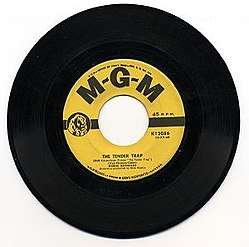Let's Call the Whole Thing Off
"Let's Call the Whole Thing Off" is a song written by George Gershwin and Ira Gershwin for the 1937 film Shall We Dance, where it was introduced by Fred Astaire and Ginger Rogers as part of a celebrated dance duet on roller skates.[1] The music sheet is annotated with the word "Brightly".[2] The song is most famous for its "You like tomato /təˈmeɪtə/ / And I like to-mah-to /təˈmɑːtə/" and other verses comparing British and American English accent.
| "Let's Call the Whole Thing Off" | |
|---|---|
 | |
| Song | |
| Released | May 7, 1937 |
| Genre | Traditional pop |
| Songwriter(s) | George Gershwin and Ira Gershwin |
The differences in pronunciation are not simply regional, however, but serve more specifically to identify class differences. At the time, typical American pronunciations were considered less "refined" by the upper-class, and there was a specific emphasis on the "broader" a sound.[3] This class distinction with respect to pronunciation has been retained in caricatures, especially in the theater, where the longer a pronunciation is most strongly associated with the word darling.[4]
The song was ranked No. 34 on AFI's 100 Years...100 Songs.[5]
Recordings
- Fred Astaire with Johnny Green & His Orchestra (1937)[6]
- Billie Holiday – Lady Day: The Complete Billie Holiday on Columbia 1933–1944 (1937)
- Sam Cooke – Tribute to the Lady (1959)
- Ella Fitzgerald – on Ella Fitzgerald Sings the George and Ira Gershwin Songbook (1959),[7] on the 1983 Pablo release Nice Work If You Can Get It, and in a 1957 duet with Louis Armstrong on Ella and Louis Again.
- Bing Crosby and Rosemary Clooney recorded the song for their radio show in 1960[8] and it was subsequently released on the CD Bing & Rosie - The Crosby-Clooney Radio Sessions (2010).[9]
- Uri Caine – Rhapsody in Blue (2013)
- Willie Nelson with Cyndi Lauper on Summertime: Willie Nelson Sings Gershwin (2016)
The song has been re-used in filmmaking and television production, most notably in When Harry Met Sally... – where it is performed by Harry Connick Jr. – and The Simpsons.
In the February 18, 1970, Anne Bancroft television special, "Annie: The Women in the Life of a Man," Bancroft appears in a comedy sketch with David Susskind where she plays a hapless singer in an audition who sings the song from sheet music, cluelessly ignoring the different pronunciation of to-may-to and to-mah-to, etc.[10] Ira Gershwin relates a similar incident in his 1959 book.[11]
The tune was also featured in the 2012 Broadway Musical Nice Work If You Can Get It.
References
- Philip Furia (1997). Ira Gershwin: The Art of the Lyricist. Oxford University Press. p. 147. ISBN 978-0-19-535394-5.
- Yorktown Music Press (1 January 2011). The Joy of... George Gershwin. Yorktown Music Press. p. 1. ISBN 978-1-78323-824-8.
- Flexner, Stuart Berg (1982). Listening to America: An Illustrated History of Words and Phrases from our Lively and Splendid Past. Simon and Schuster. p. 511.
- Dunkling, Leslie (1990). A Dictionary of Epithets and Terms of Address. Routledge. p. 86.
- "America's Greatest Music in the Movies" (PDF). Archived from the original (PDF) on 2011-07-16. Retrieved 2011-10-04.
- "Astaire on 78". America.net. Archived from the original on 2011-09-27. Retrieved 2011-10-04.
- "Ella Fitzgerald Discography – Part 2 – The Verve Years part 1". Ellafitzgerald.altervista.org. Archived from the original on 2011-09-29. Retrieved 2011-10-04.
- "A Bing Crosby Discography". BING magazine. International Club Crosby. Retrieved December 8, 2017.
- "allmusic.com". allmusic.com. Retrieved December 8, 2017.
- "Broadway.com". Retrieved November 13, 2018.
- Gershwin, Ira (1959). Lyrics on Several Occasions (First ed.). New York: Knopf. OCLC 538209.
Further reading
- Furia, Philip (1996). Ira Gershwin: The Art of the Lyricist (First ed.). New York: Oxford University Press. ISBN 0-19-508299-0.
- Rosenberg, Deena Ruth (1991). Fascinating Rhythm: The Collaboration of George and Ira Gershwin. University of Michigan Press. ISBN 978-0-472-08469-2.